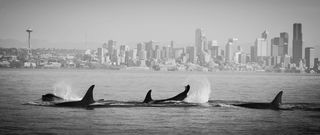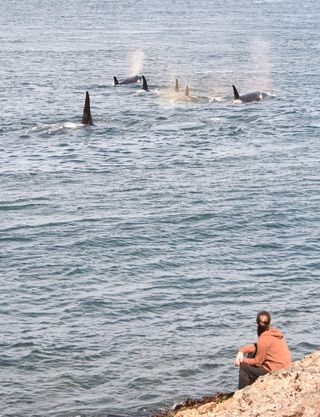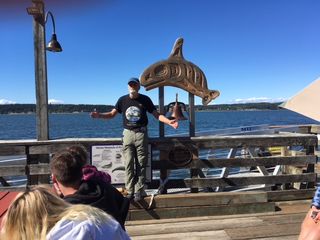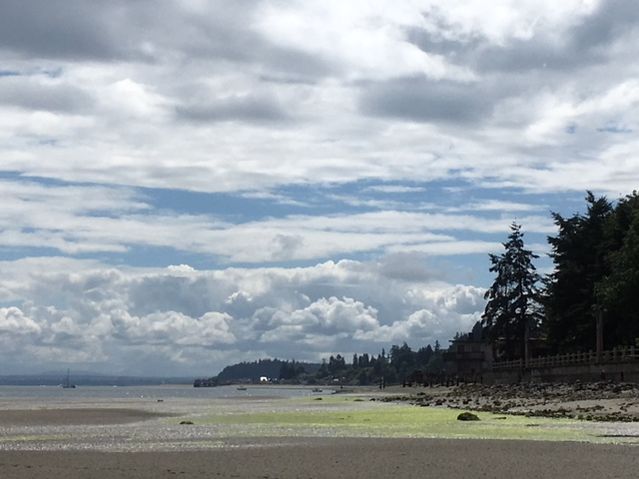Grief
Let's Breach for Blackfish
Did you grieve with the whale Tahlequah? We need to reconstruct her ecosystem.
Posted August 7, 2018

It’s Day 11 of Tahlequah’s vigil. And for the last few nights I’ve slept with a stuffed animal for the first time since I was a little girl. It’s a killer whale freed from deep storage.
An orca. A blackfish. My son had her through all the years of childhood and his tween era. He had her while I wrote a novel inspired by real-life sacred beings and told him the stories of the blackfish. Of SeaWorld. Of the captures, the killings, and the Salish Sea. Of the dams blocking the whales’ salmon. She was a place to help him hold the truths he was learning.
Now he's is a young man who has moved on to much different ways to hold, and speak, those truths. Still, I had to find her. For a few days, holding this little stuffed whale gave my body a place to put the grief I share with J35, Tahlequah.
Every mother knows such coping mechanisms.

How do you find words as you begin to realize you’re witnessing a unique group of sentient, social beings endure a death rattle of extinction? That they are on a tour of grief unlike anything the world has seen?
By day 10 my heart revolts: the little whale is not an effective coping mechanism.
Solving what’s at stake is.
Not just holding the truths, but speaking the truths... to power.
Their's would be another extinction resulting from a culture of systemic domination. And because of who these whales are, it would be a loss unspeakably vast. But cultures change. We have examples of cultures who lived harmoniously with people and planet for thousands of years.
Culture changes with the human heart.
Or, with a whale’s. Before beginning her arduous vigil, Tahlequah and her closest kin performed a ceremony in a sheltered cove of San Juan Island. According to a human resident, on the night of the calf’s death July 24th:
“At sunset, a group of 5-6 females gathered at the mouth of the cove in a close, tight-knit circle, staying at the surface in a harmonious circular motion for nearly 2 hours. As the light dimmed, I was able to watch them continue what seemed to be a ritual or ceremony. They stayed directly centered in the moonbeam, even as it moved. The lighting was too dim to see if the baby was still being kept afloat. It was both sad and special to witness this behavior. My heart goes out to J35 and her beautiful baby; bless it's soul.” (The Center for Whale Research)
Knowing the facts about orca intelligence, family bonds, and the ancient capacity for human-whale connection, it is reasonable to interpret Tahlequah’s tour of grief as a cry for human help.
So the whales, so ourselves.
This is the latest loss in a snowballing list suffered by a family starving to death. Half of the calves born in the last five years have died, and four-year-old J50, Scarlet—known as the standard bearer of hope for the SRKW’s recovery—is nearing death from starvation. Dr. Ken Balcomb is the founder and Chief Scientist of the Center for Whale Research, San Juan Island, and grandfather to the SKRWs 40+ year legacy of life history observations and data. He says we have no more than five years to stabilize—to feed—these whales before extinction closes its jaws.
“This may be the last generation that we get to see of the whales,” Balcomb said in a recent Washington Post story. “Their reproductive life is about 25 years. We’ve wasted 20 of those years just having meetings and conference calls and writing reports and wringing our hands.”
As I write on Friday August 3, no major news outlet has connected Tahlequah’s tour of grief to the dams. Just days before she lost her calf, The New York Times covered many of the current challenges facing the Southern Residents, such as increasing boat traffic, noise pollution, accumulation of toxic chemicals, imminent risks of oil spills, and others. But the word "dam" didn't appear once.
Fifty years ago, the Southern Residents had lost a third to half of their population to the captivity industry* as the NYTs piece did address. This whale genocide set them on a precipice with little resilience to navigate the ongoing impacts of the Pacific Northwest dams. Dams that continue to monkey-wrench the whales’ watershed, their lifeblood.
Their salmon.
Pacific Northwest dams have caused a catastrophic loss of salmon—and deeply eroded a healthy PNW ecosystem—over the decades they were built (for a quick overview see the U.S. Fish and Wildlife Service, NOAA Fisheries, and the Northwest Power and Conservation Council). Some are fitted with appropriate and (somewhat) helpful salmon passage, others are not. The four lower Snake River dams are already reviewed as straightforward earthen-bank breaches (with no need to remove concrete structures); they are old and require updates that will cost tax payers increasing and substantial amounts of money; they make little power that is easily made up for by local sustainable alternatives; and some block critical salmon access to one of the largest areas of unspoiled wild Chinook spawning habitat in the world: much of my home state of Idaho.
Removing the four lower Snake River dams would unleash a rapid salmon recovery the world has never seen.
I think about our students, many of them Nez Perce, whose blood runs thick with ancient stewardship of rivers and salmon. I think about how moved and outraged they were as we spent most of June, only weeks ago, spotlighting the connections between Blackfish, Salmon, Dams, and themselves. And about the connections they made with the coastal tribes, including the Lummi. How they recognized their own ancestral bonds of indigenous stewardship of the blackfish and salmon.

I recall their grim faces as they heard Howard Garrett, founder of Orca Network, describe Tokitae—the last living Southern Resident orca taken from her family, still surviving in concrete tank 48 years later while her mother Ocean Sun, swims free. And how different they looked hours later, open and hopeful, at a sacred Lummi site planned for Toki's retirement to the Salish Sea. I think about whether Ocean Sun might be hungry right now.
Our students' had high hopes to encounter the Southern Residents they’d come to love. But we saw no whales. Not even in June when, in all the years past, the Southern Residents would be fishing the San Juan Islands. Instead, they were hours away in Canada near the Fraser River, desperately looking for Chinook.

We couldn't know as we scanned the blue horizon from the deck of The Odyssey, that Tahlequah would have been nearing the end of her pregnancy, perhaps crazy with hunger. Her family was likely doing all they could to feed their one pregnant mother of the last three years.
I wonder about their hearts—students who have their own challenges, connected to a legacy of systemic oppression. How do they feel as this latest horror unfolds before their eyes on the phones they watch constantly. The things they see, the despair they feel.
And I think: Not on our watch.
Solutions happen when human hearts change.
So maybe by the time this story runs next week Tahlequah will have let her baby go—not in peace, but with a world’s hope for harmony. Maybe the major news outlets will have covered breaching the dams (The Seattle Times ran this cover story with a spotlight on dam breaching, on Sunday Day 13). Maybe Governor Jay Inlee’s Southern Resident Killer Whale Recovery and Task Force will have made breaching these four dams an immediate and urgent priority (Over the weekend, Governor Inslee asked the Task Force to consider breaching and the task force seeks immediate public comment here). And maybe a tribal elder, ancient blood steward to the PNW, will speak to the immense legacy of interconnection we risk by letting the dams stand. (Lucinda George Simpson, Nez Perce elder spoke powerfully at the Seattle Times).
So the whales, so ourselves.
Tahlequah changed us. In a matter of days.
So maybe, fierce brave Tahlequah, maybe when September comes and we say prayers for you, your little one, and your family at the Free the Snake Flotilla… maybe, just maybe, the first scoops of dirt will have been removed.
And the rivers will soon run free, unleashing the salmon who will feed you and your next baby.
*See Puget Sound Whales For Sale by Sandra Pollard.
Governor Inslee’s Orca Recovery Task Force wants your immediate input at this simple short survey. The task force meets TODAY as this story goes live, Tuesday August 7. They seek public comments on this crisis now, and also welcome your input in the future. If you comment August 7 at the survey, your voice will have a substantial impact.
Learn more about the simple plan already in place to breach the Four Lower Snake River Dams at: www.damsense.org and see the Dam Sense Facebook page for helpful language for public comments.
Other resources:
- Save Our Wild Salmon
- Center for Whale Research
- Orca Network
- NOAA Fisheries West Coast Region: New Page Tracking J50 & J35 Status (included links to other good resources)
Rachel Clark is the author of The Blackfish Prophecy, a novel for young adults endorsed by Dr. Jane Goodall and used as the common read in Bridge Idaho’s pilot curriculum “Killer Whales, Salmon, & You.” Bridge Idaho is a TRIO-Inspire Project at the University of Idaho that supports low-income, first generation native and non-native students and their communities, with education and models of healthy cultural change that foster their aspirations to go to college.
She is writing the first sequel to The Blackfish Prophecy, which spotlights the impacts of dams on blackfish, salmon, and our interconnected families.





